Abstract
1. When pancreatic islets were exposed to a K+-free medium, the intracellular concentration of K+ was decreased and that of Na+ increased. 2. In the K+-deprived islets, the utilization of [5-3H]glucose, output of lactic acid and oxidation of [U-14C]-glucose were decreased by about 30–40% below the control values found at normal extracellular K+ concentration (5.0mm). However, the oxidation of [U-14C]pyruvate was unaffected. 3. The omission of extracellular K+ little affected the production of 14CO2 from islets prelabelled with [U-14C]palmitate and incubated in the absence of glucose, despite the fact that K+ deprivation significantly increased the ATP concentration and ATP/ADP concentration ratio in the glucose-deprived islets. 4. At normal K+ concentration, glucose increased the concentrations of phosphoenolpyruvate, NAD(P)H and ATP in the islets. In the glucose-stimulated islets, the concentration of phosphoenolpyruvate, but not that of either NAD(P)H or ATP, was higher in the absence than in the presence of extracellular K+. In islet homogenates, the activity of pyruvate kinase (EC 2.7.1.40) was stimulated by K+ (optimal activity at 100–150mm-K+) and inhibited by Na+ (except at very low K+ concentrations). 5. K+ could be replaced by NH4+, Rb+, Cs+ or Na+ to maintain, at least to some extent, pyruvate kinase activity in islet homogenates. Addition of Rb+ or Cs+, but not NH4+, to K+-deprived media also increased [U-14C]glucose oxidation by intact islets. 6. The omission of K+ did not cause any obvious anomaly in the apparent dependency of 45Ca2+ net uptake on NAD(P)H concentration in the islets. 7. These data suggest that the coupling between metabolic and ionic events in the islet cells involves feedback mechanisms through which glucose oxidation may be modulated by cationic factors.
Full text
PDF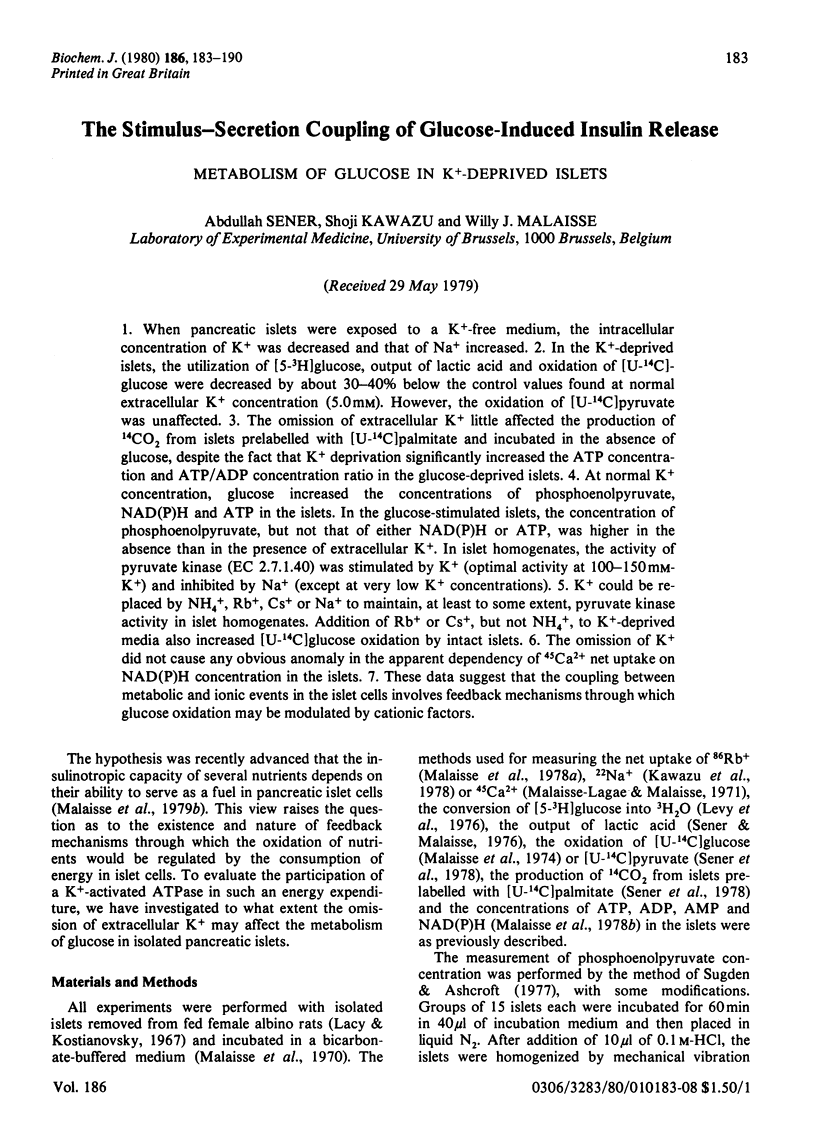
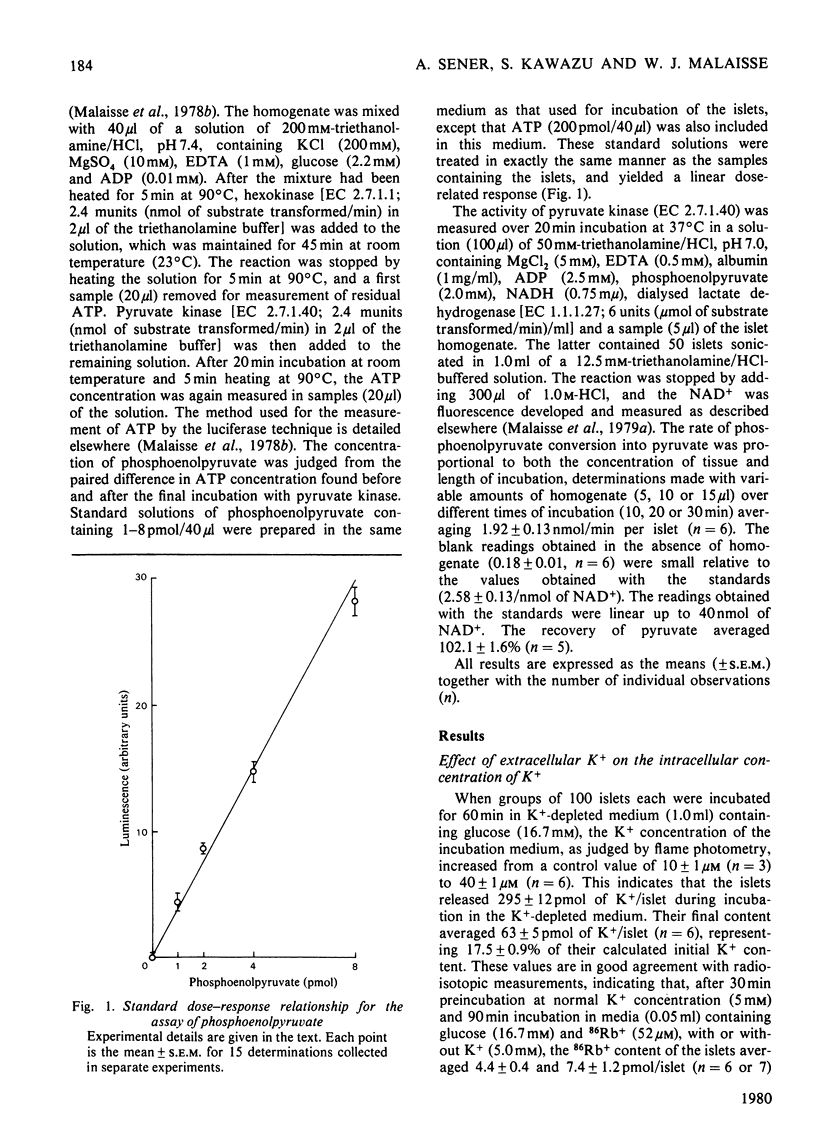
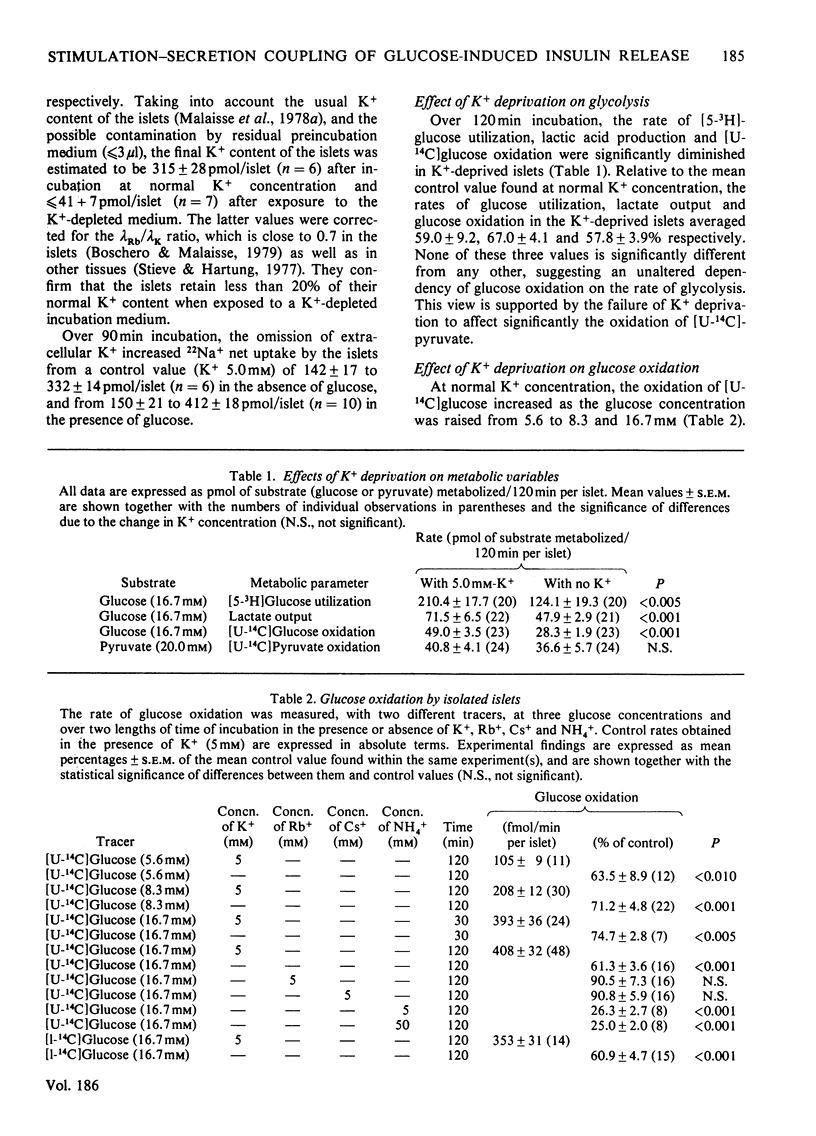

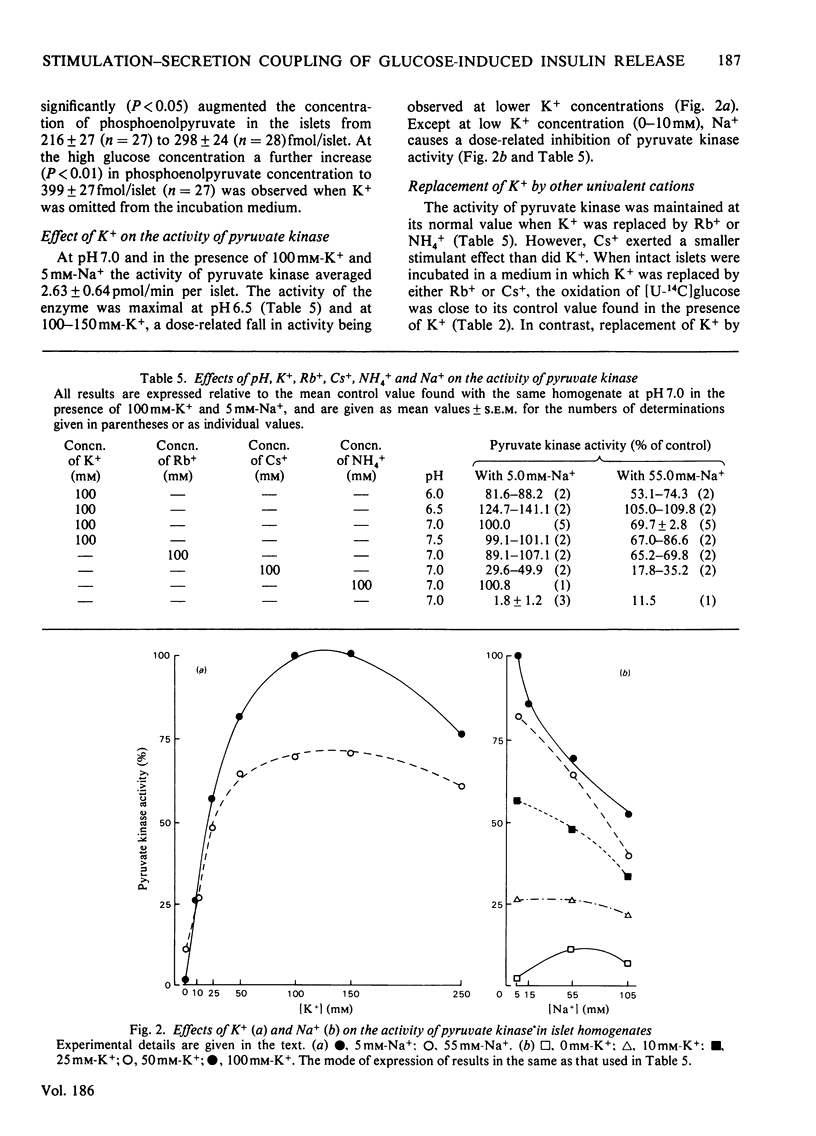
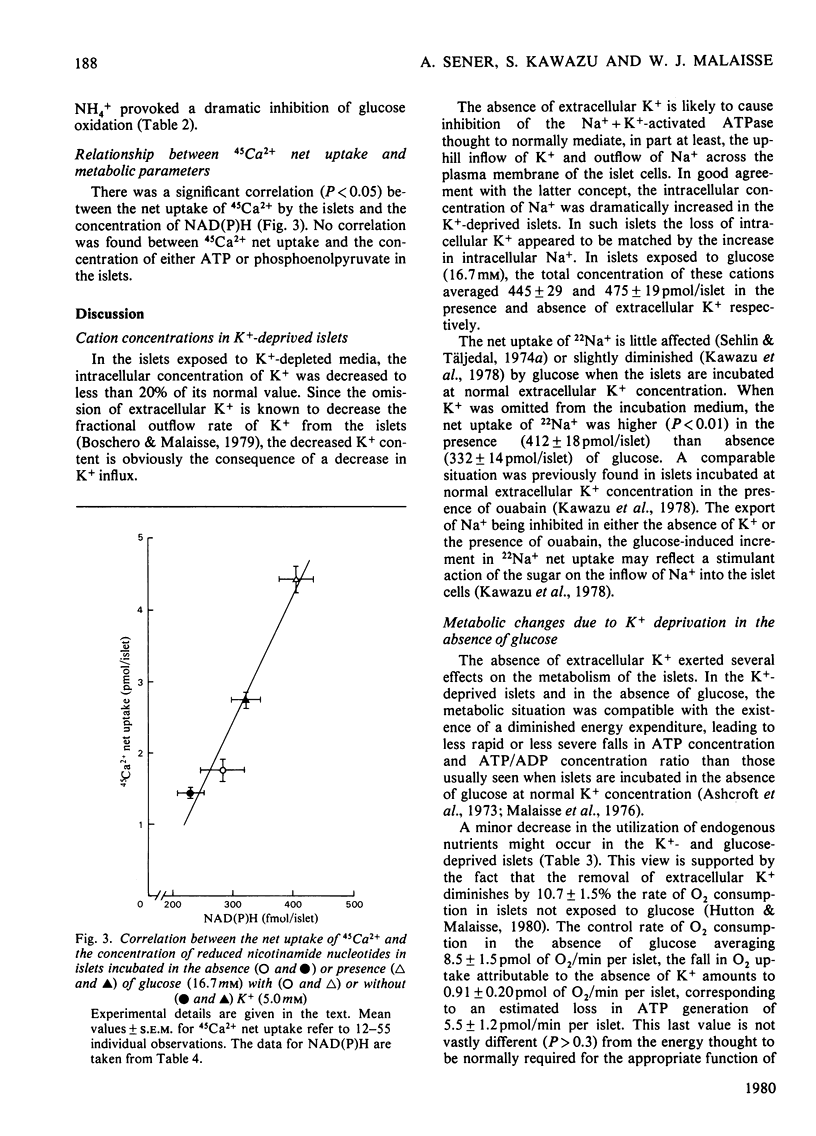
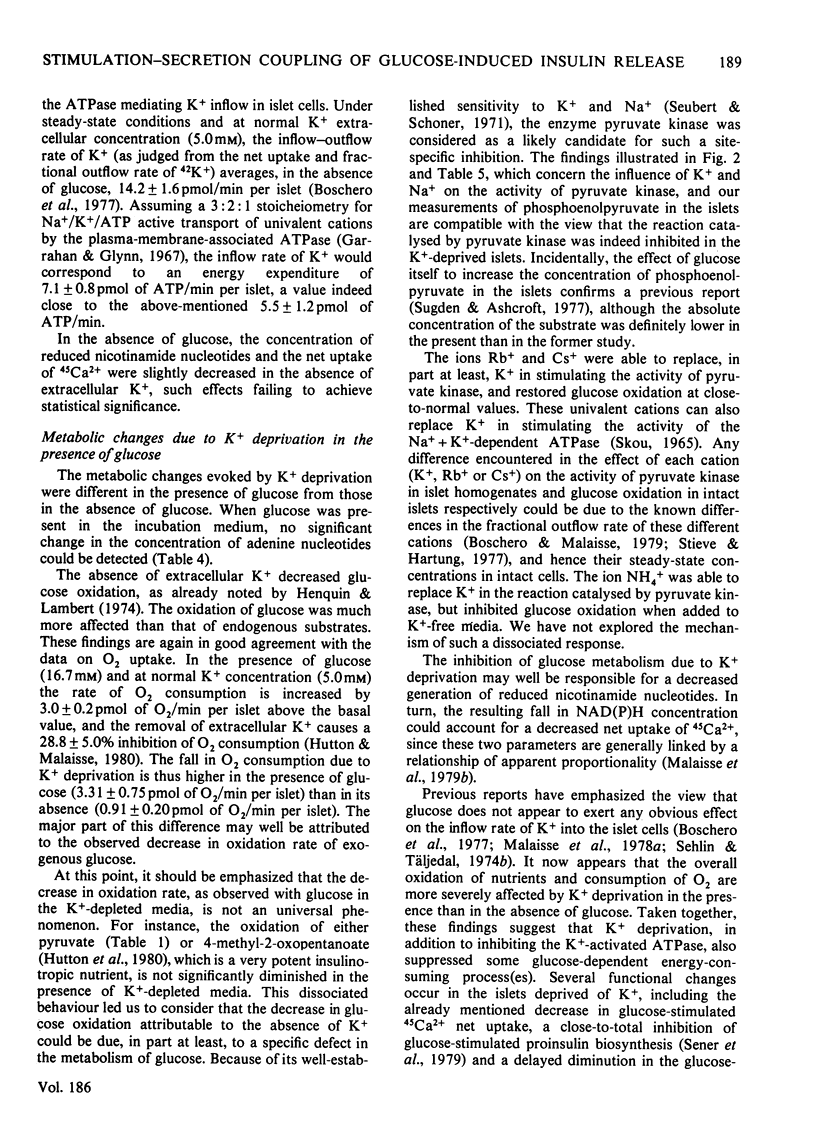
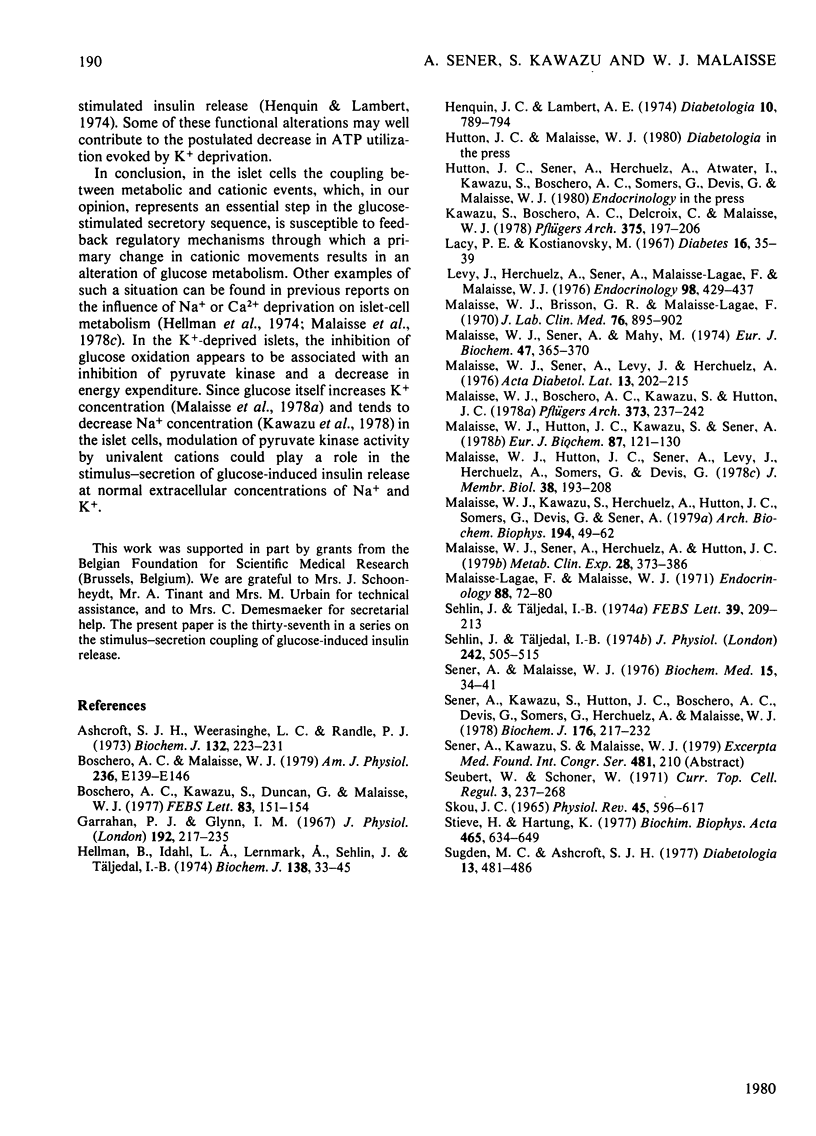
Selected References
These references are in PubMed. This may not be the complete list of references from this article.
- Ashcroft S. J., Weerasinghe L. C., Randle P. J. Interrelationship of islet metabolism, adenosine triphosphate content and insulin release. Biochem J. 1973 Feb;132(2):223–231. doi: 10.1042/bj1320223. [DOI] [PMC free article] [PubMed] [Google Scholar]
- Boschero A. C., Kawazu S., Duncan G., Malaisse W. J. Effect of glucose on K+ handling by pancreatic islets. FEBS Lett. 1977 Nov 1;83(1):151–154. doi: 10.1016/0014-5793(77)80662-5. [DOI] [PubMed] [Google Scholar]
- Boschero A. C., Malaisse W. J. Stimulus-secretion coupling of glucose-induced insulin release. XXIX. Regulation of 86Rb+ efflux from perfused islets. Am J Physiol. 1979 Feb;236(2):E139–E146. doi: 10.1152/ajpendo.1979.236.2.E139. [DOI] [PubMed] [Google Scholar]
- Garrahan P. J., Glynn I. M. The stoicheiometry of the sodium pump. J Physiol. 1967 Sep;192(1):217–235. doi: 10.1113/jphysiol.1967.sp008297. [DOI] [PMC free article] [PubMed] [Google Scholar]
- Hellman B., Idahl L. A., Lernmark A., Sehlin J., Täljedal I. B. The pancreatic beta-cell recognition of insulin secretagogues. Effects of calcium and sodium on glucose metabolism and insulin release. Biochem J. 1974 Jan;138(1):33–45. doi: 10.1042/bj1380033. [DOI] [PMC free article] [PubMed] [Google Scholar]
- Henquin J. C., Lambert A. E. Cationic environment and dynamics of insulin secretion. III. Effect of the absence of potassium. Diabetologia. 1974 Dec;10(6):789–794. doi: 10.1007/BF01219542. [DOI] [PubMed] [Google Scholar]
- Kawazu S., Boschero A. C., Delcroix C., Malaisse W. J. The stimulus-secretion coupling of glucose-induced insulin release. XXVIII. Effect of glucose on Na+ fluxes in isolated islets. Pflugers Arch. 1978 Jul 18;375(2):197–206. doi: 10.1007/BF00584244. [DOI] [PubMed] [Google Scholar]
- Lacy P. E., Kostianovsky M. Method for the isolation of intact islets of Langerhans from the rat pancreas. Diabetes. 1967 Jan;16(1):35–39. doi: 10.2337/diab.16.1.35. [DOI] [PubMed] [Google Scholar]
- Levy J., Herchuelz A., Sener A., Malaisse-Lagae F., Malaisse W. J. Cytochalasin B-induced impariment of glucose metabolism in islets of Langerhans. Endocrinology. 1976 Feb;98(2):429–437. doi: 10.1210/endo-98-2-429. [DOI] [PubMed] [Google Scholar]
- Malaisse-Lagae F., Malaisse W. J. The stimulus-secretion coupling of glucose-induced insulin release. 3. Uptake of 45 calcium by isolated islets of Langerhans. Endocrinology. 1971 Jan;88(1):72–80. doi: 10.1210/endo-88-1-72. [DOI] [PubMed] [Google Scholar]
- Malaisse W. J., Boschero A. C., Kawazu S., Hutton J. C. The stimulus secretion coupling of glucose-induced insulin release. XXVII. Effect of glucose on K+ fluxes in isolated islets. Pflugers Arch. 1978 Mar 20;373(3):237–242. doi: 10.1007/BF00580830. [DOI] [PubMed] [Google Scholar]
- Malaisse W. J., Brisson G., Malaisse-Lagae F. The stimulus-secretion coupling of glucose-induced insulin release. I. Interaction of epinephrine and alkaline earth cations. J Lab Clin Med. 1970 Dec;76(6):895–902. [PubMed] [Google Scholar]
- Malaisse W. J., Hutton J. C., Sener A., Levy J., Herchuelz A., Devis G., Somers G. Calcium antagonists and islet function: VII. Effect of calcium deprivation. J Membr Biol. 1978 Jan 18;38(3):193–208. doi: 10.1007/BF01871922. [DOI] [PubMed] [Google Scholar]
- Malaisse W. J., Kawazu S., Herchuelz A., Hutton J. C., Somers G., Devis G., Sener A. The stimulus secretion coupling of glucose-induced insulin release. Arch Biochem Biophys. 1979 Apr 15;194(1):49–62. doi: 10.1016/0003-9861(79)90594-0. [DOI] [PubMed] [Google Scholar]
- Malaisse W. J., Sener A., Herchuelz A., Hutton J. C. Insulin release: the fuel hypothesis. Metabolism. 1979 Apr;28(4):373–386. doi: 10.1016/0026-0495(79)90111-2. [DOI] [PubMed] [Google Scholar]
- Malaisse W. J., Sener A., Levy J., Herchuelz A. The stimulus-secretion coupling of glucose-induced insulin release. XXII. Qualitative and quantitative aspects of glycolysis in isolated islets. Acta Diabetol Lat. 1976 Sep-Dec;13(5-6):202–215. doi: 10.1007/BF02581118. [DOI] [PubMed] [Google Scholar]
- Malaisse W. J., Sener A., Mahy M. The stimulus-secretion coupling of glucose-induced insulin release. Sorbitol metabolism in isolated islets. Eur J Biochem. 1974 Sep 1;47(2):365–370. doi: 10.1111/j.1432-1033.1974.tb03701.x. [DOI] [PubMed] [Google Scholar]
- SKOU J. C. ENZYMATIC BASIS FOR ACTIVE TRANSPORT OF NA+ AND K+ ACROSS CELL MEMBRANE. Physiol Rev. 1965 Jul;45:596–617. doi: 10.1152/physrev.1965.45.3.596. [DOI] [PubMed] [Google Scholar]
- Sehlin J., Täljedal I. B. Sodium uptake by microdissected pancreatic islets: effects of ouabain and chloromercuribenzene-p-sulphonic acid. FEBS Lett. 1974 Feb 15;39(2):209–213. doi: 10.1016/0014-5793(74)80052-9. [DOI] [PubMed] [Google Scholar]
- Sehlin J., Täljedal I. B. Transport of rubidium and sodium in pancreatic islets. J Physiol. 1974 Oct;242(2):505–515. doi: 10.1113/jphysiol.1974.sp010720. [DOI] [PMC free article] [PubMed] [Google Scholar]
- Sener A., Kawazu S., Hutton J. C., Boschero A. C., Devis G., Somers G., Herchuelz A., Malaisse W. J. The stimulus-secretion coupling of glucose-induced insulin release. Effect of exogenous pyruvate on islet function. Biochem J. 1978 Oct 15;176(1):217–232. doi: 10.1042/bj1760217. [DOI] [PMC free article] [PubMed] [Google Scholar]
- Sener A., Malaisse W. J. Measurement of lactic acid in nanomolar amounts. Reliability of such a method as an index of glycolysis in pancreatic islets. Biochem Med. 1976 Feb;15(1):34–41. doi: 10.1016/0006-2944(76)90072-7. [DOI] [PubMed] [Google Scholar]
- Stieve H., Hartung K. Kinetics of 42K and 86Rb loss from the crayfish retina in the dark and the effect of light on the rate of isotope loss. Biochim Biophys Acta. 1977 Mar 17;465(3):634–649. doi: 10.1016/0005-2736(77)90279-6. [DOI] [PubMed] [Google Scholar]
- Sugden M. C., Ashcroft S. J. Phosphoenolpyruvate in rat pancreatic islets: a possible intracellular trigger of insulin release? Diabetologia. 1977 Sep;13(5):481–486. doi: 10.1007/BF01234500. [DOI] [PubMed] [Google Scholar]


